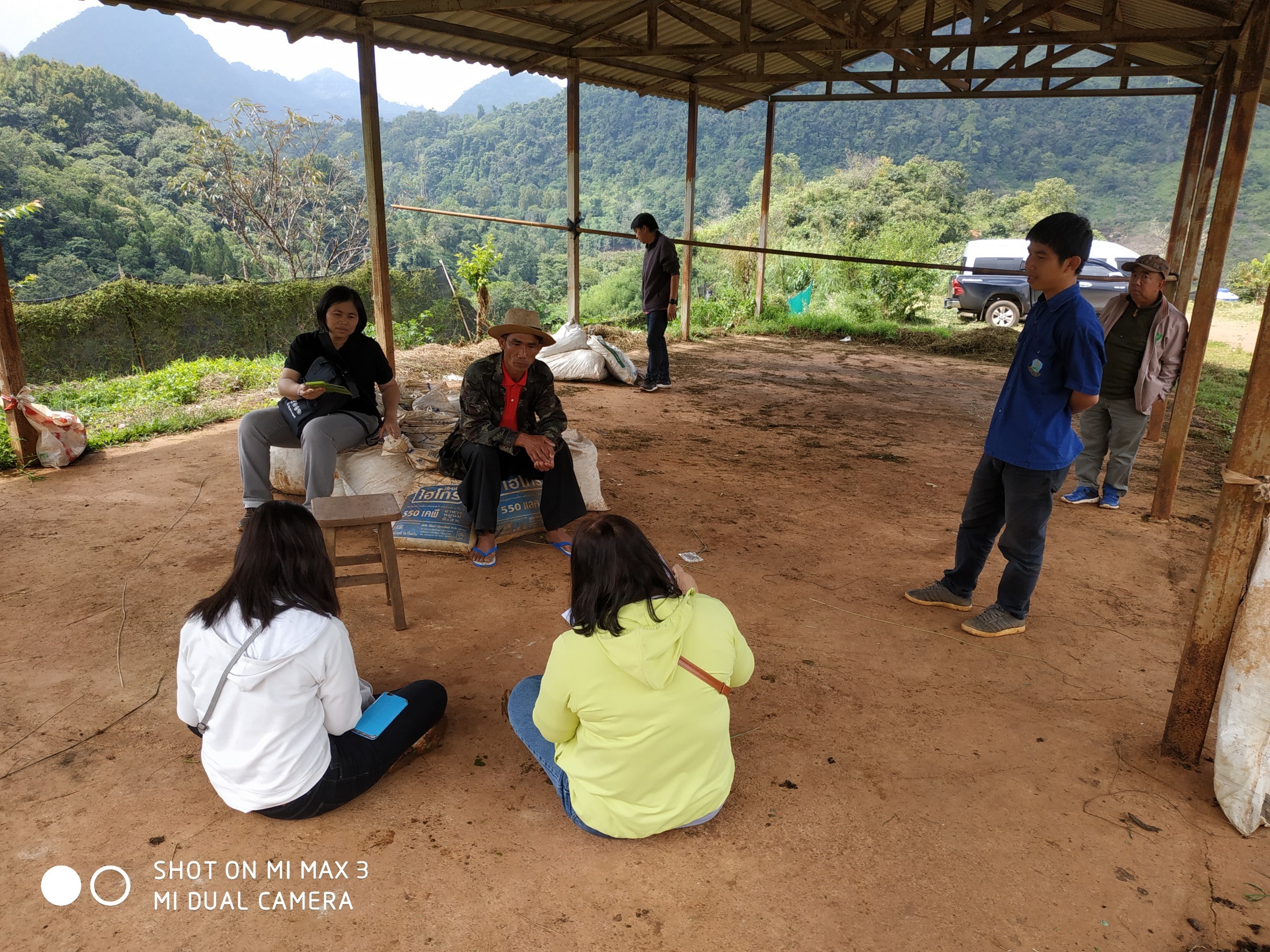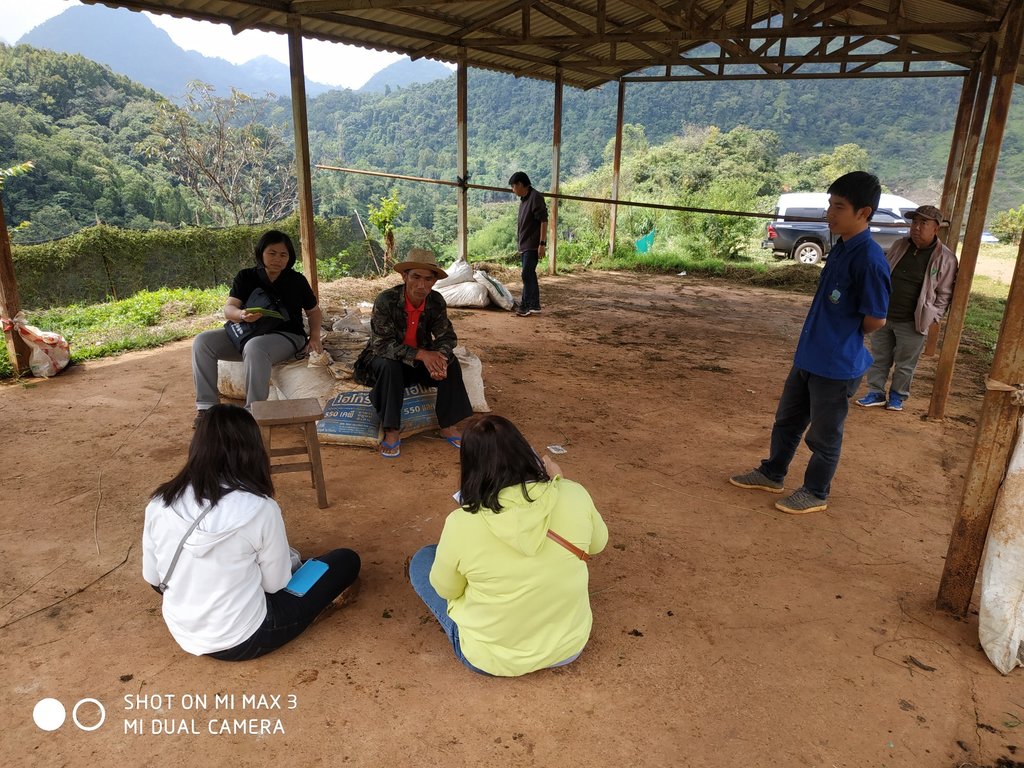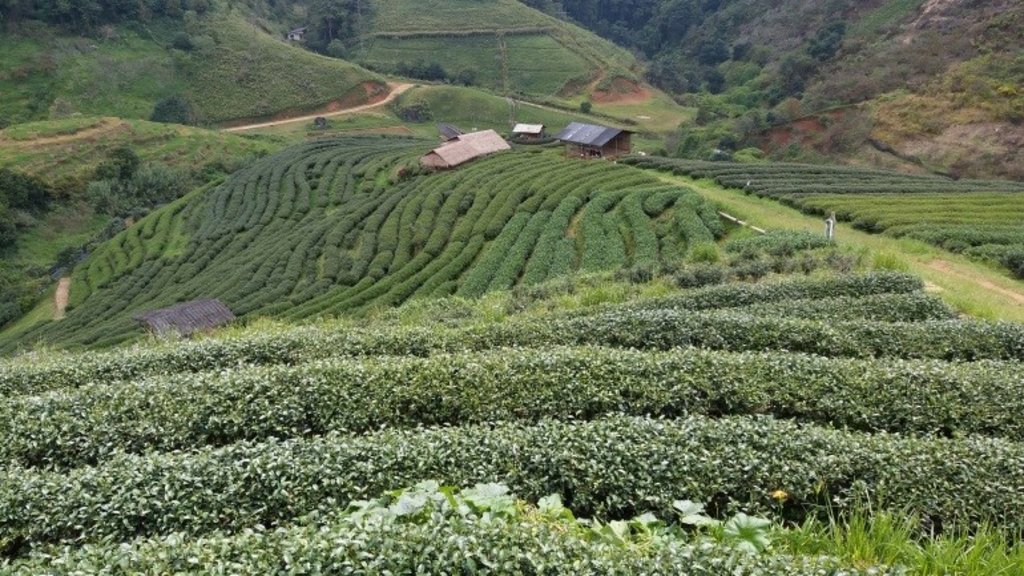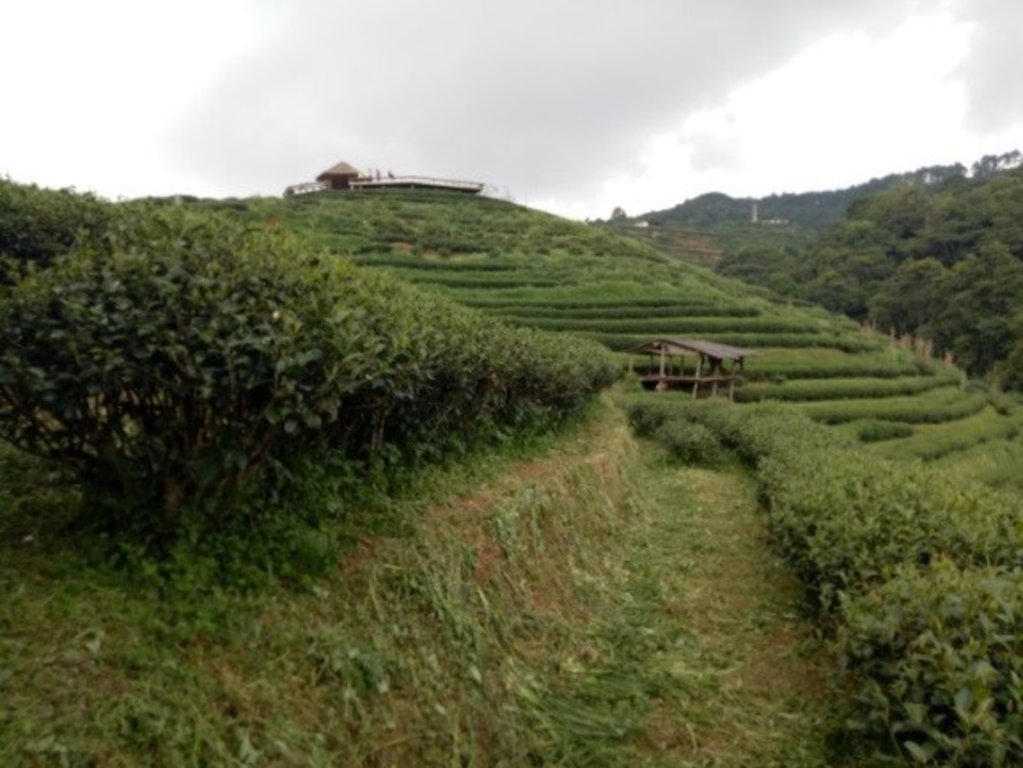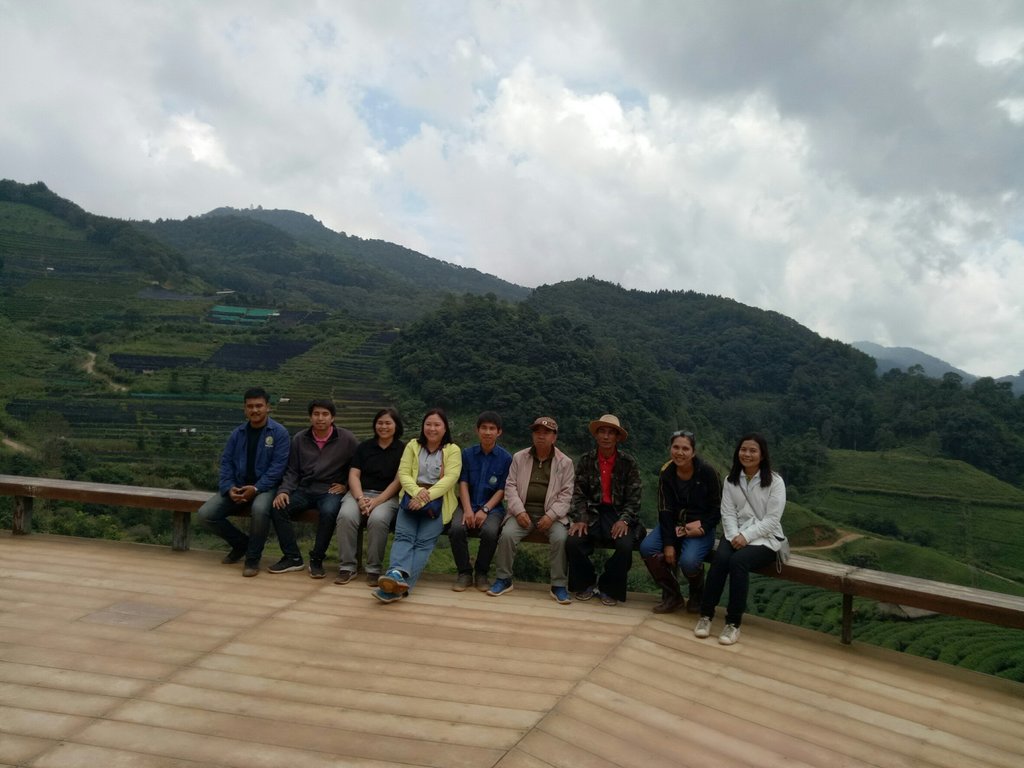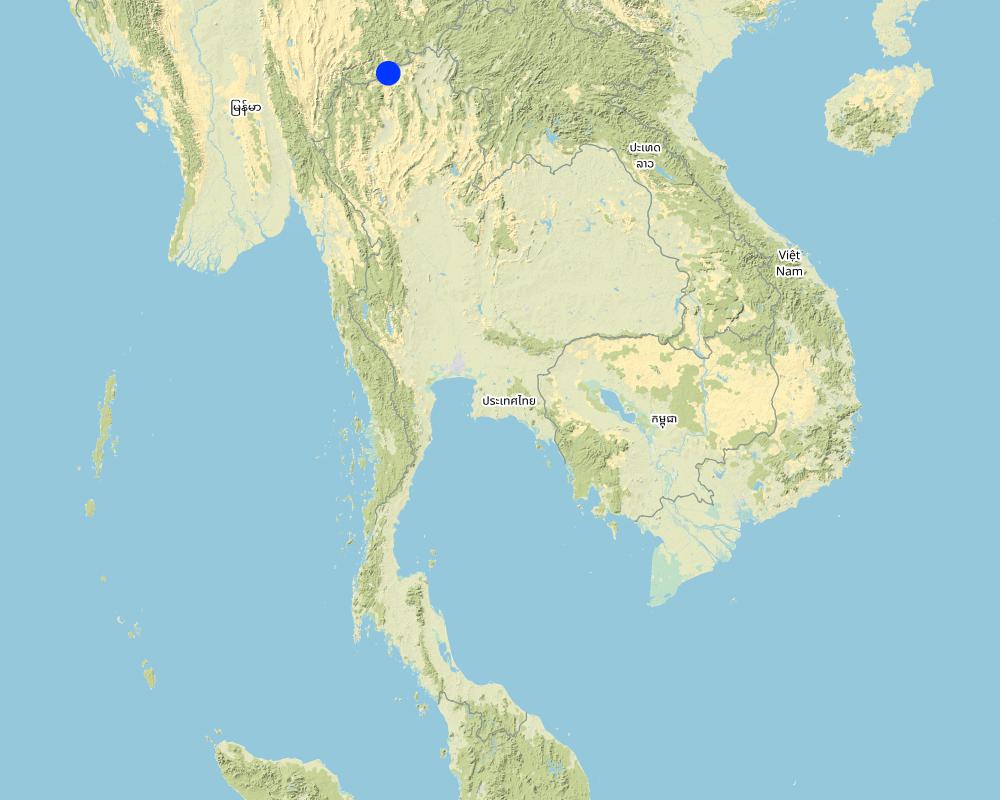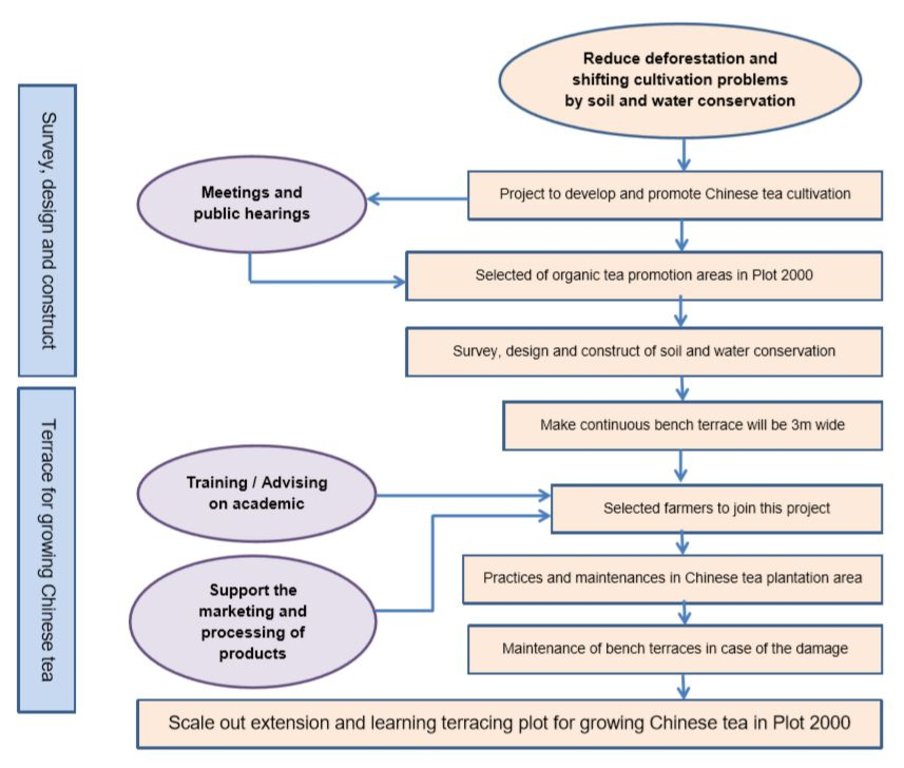Promotion of Organic Tea Production under Bench Terraces [ໄທ]
- ການສ້າງ:
- ປັບປູງ:
- ຜູ້ສັງລວມຂໍ້ມູນ: Pitayakon Limtong
- ບັນນາທິການ: –
- ຜູ້ທົບທວນຄືນ: Rima Mekdaschi Studer, William Critchley
Continuous bench terrace
approaches_4282 - ໄທ
ເບິ່ງພາກສ່ວນ
ຂະຫຍາຍທັງໝົດ ຍຸບທັງໝົດ1. ຂໍ້ມູນທົ່ວໄປ
1.2 ລາຍລະອຽດ ການຕິດຕໍ່ ຂອງບຸກຄົນທີ່ຊັບພະຍາກອນ ແລະ ສະຖາບັນ ການມີສ່ວນຮ່ວມ ໃນການປະເມີນຜົນ ແລະ ເອກະສານ ຂອງວິທີທາງ
ບຸກຄົນສຳຄັນ (ຫຼາຍຄົນ)
co-compiler:
Tipvong Tanomkwan
1760 ต่อ 2235 / 0879172421
aoy.tvong.@gmail.com
Land Development Department
Pahotyothin Rd., Chatuchak, Bangkok 10900
ໄທ
ຜູ້ນໍາໃຊ້ທີ່ດິນ:
Mokngoen Jai
0658720601 / -
- / -
Palaung hill tribe, land user in Plot 2000
Mu 5, Khum village, Mae Ngon sub-district, Fang district, Chiang Mai province, 50110
ໄທ
Tapangtong Werapong
0987488087 / -
- / -
Angkhang Royal Agricultural Station
Mu 5, Khum village, Mae Ngon sub-district, Fang district, Chiang Mai province, 50110
ໄທ
Boonchoo Sontaya
- / -
- / -
Royal Project Land Development Center, Land Development Department
164 Mu 3, Chiang Mai-Fang Road, Don Kaeo subdistrict, Mae Rim district, Chiang Mai province, 50180
ໄທ
ຊື່ຂອງ ສະຖາບັນການຈັດຕັ້ງ ທີ່ອໍານວຍຄວາມສະດວກ ໃນການສ້າງເອກກະສານ ຫຼື ປະເມີນແນວທາງ (ຖ້າກ່ຽວຂ້ອງ)
Land Development Department (Land Development Department) - ໄທ1.3 ເງື່ອນໄຂ ຂອງການນໍາໃຊ້ເອກກະສານຂໍ້ມູນ ຂອງ WOCAT
ເມື່ອໃດທີ່ໄດ້ສັງລວມຂໍ້ມູນ (ຢູ່ພາກສະໜາມ)?
19/10/2018
ຜູ້ສັງລວມ ແລະ ບັນດາຜູ້ຕອບແບບສອບຖາມ ຍອມຮັບໃນເງື່ອນໄຂ ການນໍາໃຊ້ຂໍ້ມູນເອກະສານ ທີ່ສ້າງຂື້ນ ໂດຍຜ່ານ ອົງການ WOCAT:
ແມ່ນ
2. ພັນລະນາ ແນວທາງການຄຸ້ມຄອງນໍາໃຊ້ດິນແບບຍືນຍົງ
2.1 ການອະທິບາຍ ໂດຍຫຍໍ້ ຂອງວິທີທາງ
Promotion of continuous bench terraces for sustainable tea plantations in steep areas of the northern region highlands.
2.2 ການອະທິບາຍ ລາຍລະອຽດ ຂອງວິທີທາງ
ການອະທິບາຍ ລາຍລະອຽດ ຂອງວິທີທາງ:
The approach is to develop and promote sustainable agriculture on steep slopes by establishing continuous bench terraces. Under this system, hilltribe farmers can produce good quality Chinese tea, and send their product to a processing factory nearby, which will create stable and high incomes and raise the quality of life. This production/ conservation system aims also to reduce deforestation and shifting cultivation problems, which lead to the degradation of soil and land. As such, soil and water conservation in this upstream sloping highland should promote and encourage appropriate sustainable land management to preserve natural resources and the environment.
In the early stage, Angkhang Royal Agricultural Station initiated this project to develop and promote Chinese tea cultivation on steep land, with close cooperation from the Land Development Department (LDD) to design the continuous bench terraces instead of the cold-climate fruit trees, which had greatly deteriorated. Local officers had allocated land (without ownership) to Palaung hilltribe people who were selected and guaranteed by the community leader for their aptitude and ability to cultivate Chinese tea according to the Good Agricultural Practices (GAP) Guidelines, and set up a Chinese tea producers group at Plot 2000. Angkhang Royal Agricultural Station organized this programme and trained them and also arranged for some local officers to advise on soil management, fertilizer use, and disease and pest control. Vetiver grass planting was introduced to maintain the terrace and road edges; compost was produced to use for improving soil properties and reducing their production cost, and cultivation materials were supplied to all land users through disbursement under the management of Doi Angkhang Agricultural Cooperatives. Local officers also supported marketing through purchasing at the guaranteed price according to the quality of the tea, and set up tea processing factories in this area. The project encourages all land users to observe and maintain their tea bushes and the land around them. Currently all land users are aware of how to sustainably use and maintain their land and soil resources. Moreover, local officers advise how to repair bench terraces themselves; however, if the damage is serious, the LDD officers will come in to help them repair.
2.3 ຮູບພາບຂອງແນວທາງ
ຂໍ້ສັງເກດໂດຍທົ່ວໄປກ່ຽວກັບການຮູບພາບ:
Data collection supports for mainstreaming and scaling-up of sustainable land management
2.4 ວີດີໂອ ຂອງວິທີທາງ
ຄວາມຄິດເຫັນ, ຄໍາອະທິບາຍຫຍໍ້:
Tea plantation in soil and water conservation measure in steep areas
ວັນທີ:
09/10/2018
ສະຖານທີ່:
Doi Ang Khang
ຊື່ຂອງຜູ້ຖ່າຍວີດີໂອ:
Ms. Somjit Lertdisayawan / Ms. Tanomkwan Tipvong
ຄວາມຄິດເຫັນ, ຄໍາອະທິບາຍຫຍໍ້:
Tea plantation farm
ວັນທີ:
21/01/2016
ສະຖານທີ່:
Doi Angkhang
ຊື່ຂອງຜູ້ຖ່າຍວີດີໂອ:
Pornthep Molee
ຄວາມຄິດເຫັນ, ຄໍາອະທິບາຍຫຍໍ້:
Angkhang Royal Agricultural Station
39 เส้นทาง เรียนรู้ ทำดี “ตามรอยพ่อ”
ວັນທີ:
15/03/2017
ສະຖານທີ່:
Angkhang Royal Agricultural Station
ຊື່ຂອງຜູ້ຖ່າຍວີດີໂອ:
Royal Project Foundation, Ford Thailand
2.5 ປະເທດ / ເຂດ / ສະຖານທີ່ບ່ອນທີ່ແນວທາງໄດ້ຖືກນໍາໃຊ້
ປະເທດ:
ໄທ
ພາກພື້ນ / ລັດ / ແຂວງ:
Chiang Mai Province
ຂໍ້ມູນເພີ່ມເຕີມຂອງສະຖານທີ່:
Extension area for Chinese tea plantation (Farm 2000) at Angkhang Royal Agricultural Station, Mae Ngon Sub-district, Fang District,Chiang Mai Province
ຄວາມຄິດເຫັນ:
Angkhang Royal Agricultural Station is the main agency to assist, support and encourage hilltribe farmers in protection and awareness of soil resources in this steep zone. Soil and water conservation measures have been used to solve the erosion problem, protect the environment, preserve the forest and enable land users to grow the Chinese tea in this area ("Farm 2000").
Map
×2.6 ວັນທີເລີ່ມຕົ້ນ ແລະ ສິ້ນສຸດ ການຈັດຕັ້ງປະຕີບັດ ວິທີທາງ
ສະແດງປີຂອງການເລີ່ມຕົ້ນ:
1999
ຖ້າຫາກບໍ່ຮູ້ຈັກປີທີ່ແນ່ນອນ, ໃຫ້ປະມານຄາດຄະເນ ເອົາມື້ທີ່ໄດ້ເລີ່ມຈັດຕັ້ງປະຕິບັດ ວິທີທາງ:
10-50 ປີ ຜ່ານມາ
ຄວາມຄິດເຫັນ:
Sustainable use of a steep area. Hill tribe farmers can utilize this continuous bench terrace land for tea plantation or other purposes for long time under GAP system.
2.7 ປະເພດຂອງແນວທາງ
- ພາຍໃຕ້ໂຄງການ / ແຜນງານ
2.8 ເປົ້າໝາຍ / ຈຸດປະສົງຫຼັກ ຂອງການຈັດຕັ້ງປະຕິບັດ ວິທີທາງ
The first objective is to enable hilltribe farmers, through suitable soil and water conservation measures, to produce good quality Chinese tea on the highland. The second objective is to create a stable income and raise the quality of life, where it is very important to ensure sustainable landuse without damaging natural resources and the environment. The third is to reduce forest encroachment problems in the highland and watershed areas of the northern region of Thailand.
2.9 ເງື່ອນໄຂອໍານວຍ ຫຼື ຂັດຂວາງການປະຕິບັດຂອງເຕັກໂນໂລຢີ / ເຕັກໂນໂລຢີການນໍາໃຊ້ຕາມແນວທາງ
ມີຄວາມສາມາດ / ເຂັ້າເຖິງຊັບພະຍາກອນດ້ານການເງິນ ແລະ ການບໍລິການ
- ອໍານວຍ
Angkhang Agricultural Cooperatives supported production factors to land users and cooperatives officers will monitor and evaluate this process.
ການກໍ່ຕັ້ງສະຖາບັນ
- ອໍານວຍ
Land user network as cooperative of tea plantation group with cooperation in compost or organic fertilizers production
ກ່ຽວກັບກົດໝາຍ (ສິດນໍາໃຊ້ດິນ, ສິດນໍາໃຊ້ນໍ້າ)
- ອໍານວຍ
Almost land users did not have right in land ownership, but they have right to use the allocated land, which these land are allocated by the Royal Project.
ນະໂຍບາຍ
- ອໍານວຍ
Government policy and Royal project supported the budget and implementation activities
ການປົກຄອງທີ່ດິນ (ການຕັດສິນໃຈ, ການປະຕິບັດ ແລະ ຂໍ້ບັງຄັບ)
- ອໍານວຍ
Royal project and government agencies regulated land use planning and take care on soil and land management in this area.
ຄວາມຮູ້ກ່ຽວກັບການຄຸ້ມຄອງ ທີ່ດິນແບບຍືນຍົງ, ການເຂົ້າເຖິງການສະໜັບສະໜູນ ທາງດ້ານວິຊາການ
- ອໍານວຍ
The officers of Angkhang Royal Agricultural Station advise land users to manage soil and land, including tea production and process.
ຕະຫຼາດ (ໃນການຊື້ວັດຖຸດິບ, ຂາຍຜະລິດຕະພັນ) ແລະ ລາຄາ
- ອໍານວຍ
They have tea processing factories in this area.
ອື່ນໆ
- ອໍານວຍ
3. ການມີສ່ວນຮ່ວມ ແລະ ບົດບາດຂອງພາກສ່ວນທີ່ກ່ຽວຂ້ອງທີ່ໄດ້ມີສ່ວນຮ່ວມ
3.1 ຜູ້ມີສ່ວນຮ່ວມ ໃນວິທີທາງ ແລະ ພາລະບົດບາດ ຂອງເຂົາເຈົ້າ
- ຜູ້ນໍາໃຊ້ດິນໃນທ້ອງຖິ່ນ / ຊຸມຊົນທ້ອງຖິ່ນ
All farmers belong to the hilltribe Palaung ethnic group.
All land users take care of bench terraces with advice from station officers.
- ອົງການຈັດຕັ້ງ ພາຍໃນຊຸມຊົນ
Angkhang Royal Agricultural Station, The Royal Project
The station officers extend and promote the occupation, encourage and advise in technology transfer the technical matter and knowledge to farmers.
- ຄູອາຈານ / ນັກຮຽນ / ນັກສຶກສາ
School children and students
Training course and study tour in the area
- ອໍານາດ ການປົກຄອງທ້ອງຖິ່ນ
Several local government agencies are directly involved in this process, including officers from the station and the Royal Project.
The station officers extend and promote the occupation, encourage and advise the farmers in technical knowledge, support production facilities and processing factory.
- ພະນັກງານຂັ້ນສູນກາງ (ຜູ້ວາງແຜນ, ຜູ້ສ້າງນະໂຍບາຍ)
Administrative officers in department and ministry level
Making decisions and creating policy
3.2 ການມີສ່ວນຮ່ວມຂອງຜູ້ນໍາໃຊ້ທີ່ດິນໃນທ້ອງຖິ່ນ / ຊຸມຊົນທ້ອງຖິ່ນໃນໄລຍະທີ່ແຕກຕ່າງກັນຂອງແນວທາງ
| ການລວບລວມ ເອົາຜູ້ນໍາໃຊ້ດິນ ໃນທ້ອງຖິ່ນ / ຊຸມຊົນທ້ອງຖິ່ນ | ໃຫ້ລະບຸ ຜູ້ໃດທີ່ມີສ່ວນຮ່ວມ ໃນແຕ່ລະກິດຈະກໍາ? | |
|---|---|---|
| ການເລີ່ມຕົ້ນ / ແຮງຈູງໃຈ | ການຮ່ວມມື | Angkhang Royal Agricultural Station created continuous bench terraces as a soil and water conservation measure in the former degraded cold-climate fruit tree plot. They informed all land users about land allocation and zoning for suitable economic crops and trees, including Chinese tea in Plot 2000. |
| ການວາງແຜນ | ການຮ່ວມມື | Almost all land users (Palaung hilltribe) have been allocated land for planting Chinese tea with good agricultural practices (GAP) system in Plot 2000. |
| ການປະຕິບັດ | ບໍ່ມີ | The LDD has been responsible for conducting soil and land survey, designing and constructing soil and water conservation measures, with close collaboration with Angkhang Royal Agricultural Station. |
| ຕິດຕາມກວດກາ / ການປະເມີນຜົນ | ການຮ່ວມມື | All Palaung hilltribe land users in this area have to maintain/repair the bench terraces in their allocated land. |
3.3 ແຜນວາດ (ຖ້າມີ)
ການອະທິບາຍ:
Flow chart Operating procedures of bench terrace:
1. The organic Chinese tea plantation project is emphasized to promote and develop career of hilltribe people around the area of Angkhang Royal Agricultural Station to reduce forest encroachment and shifting cultivation and encourage them to use the land in a sustainable way with stable and high income.
2. Angkhang Royal Agricultural Station has selected the area of old cold-climate crops where soil has deteriorated; the station officers need to reshape the land and construct suitable conservation measures in this sloping area.
3. In 1999, Land Development Department (LDD) supported in the survey, design and construction of soil and water conservation measures as continuous bench terraces. The distance between two terraces and the vertical interval (VI) depend on the slope of the area, but the cultivation area of each terrace will be 3m wide.
4. The Angkhang Royal Agricultural Station has selected farmers to join this project by considering their aptitude, ability and opportunity for further development in organic Chinese tea plantation. Almost all land users have been approved by community leaders to practice and implement following the instruction from extension officers.
5. All selected land users should practice and maintenance as recommended by station officers. In planting tea, farmers will dig a small furrow along the terrace around 30cm deep and 30cm wide. Tea seedlings will be planted in the furrow with a spacing of 40-50 cm between trees (around 2,000 plants/rai). Surface soil around these tea seedlings will be mulched to maintain suitable soil moisture.
6. Farmers will produce organic Chinese tea so they need to avoid applying chemical fertilizers and other chemical substances, but limit the use only to natural materials. Compost is applied at a rate of 2 kg/tree along both sides of the tea canopy, and incorporated about 15 cm below the soil surface. This compost rate may be applied 3 times a year.
7. The Chinese tea is usually harvested from April to December, and will receive nourishment/maintenance ( January-March). At present, the No. 12 variety has an average yield of 800 kg/rai, with some 5-6 harvests a year, while the soft stem variety has an average yield of 600 kg/rai, with some 4-5 harvests a year. The station has received a budget from the Taiwanese government and the Institute of Highland Area Development to support the processing factory building, machinery and necessary techniques.
8. Maintenance of damaged bench terraces: all land users will repair by themselves in the dry season. In the serious case of erosion, the LDD will support such maintenance. In addition, vetiver grass is planted to strengthen the edge of the terraces.
ຜູ້ຂຽນ:
Ms.Tanomkwan Tipvong
3.4 ການຕັດສິນໃຈກ່ຽວກັບການຄັດເລືອກເຕັກໂນໂລຢີຂອງການຄຸ້ມຄອງທີ່ດິນແບບຍືນຍົງ / ເຕັກໂນໂລຢີ
ລະບຸ ຄົນທີ່ຕັດສິນໃຈ ກ່ຽວກັບການຄັດເລືອກຂອງ ເຕັກໂນໂລຢີ / ເຕັກໂນໂລຢີ ຈະໄດ້ຮັບການປະຕິບັດ:
- ພາກສ່ວນກ່ຽວຂ້ອງທັງໝົດ, ເປັນສ່ວນໜຶ່ງ ຂອງວິທີທາງແບບມີສ່ວນຮ່ວມ
ອະທິບາຍ:
-
Specify on what basis decisions were made:
- ປະເມີນເອກກະສານ ຄວາມຮູ້ກ່ຽວກັບ ການຄຸ້ມຄອງ ທີ່ດິນແບບຍືນຍົງ (ຫຼັກຖານທີ່ຊ່ວຍໃນການຕັດສິນໃຈ)
- Policies and legal measures
4. ການສະໜັບສະໜູນທາງດ້ານວິຊາການ, ການສ້າງຄວາມສາມາດ, ແລະ ການຈັດການຄວາມຮູ້.
4.1 ການສ້າງຄວາມສາມາດ / ການຝຶກອົບຮົມ
ຜູ້ນໍາໃຊ້ທີ່ດິນ ຫຼື ພາກສ່ວນກ່ຽວຂ້ອງອື່ນໆ ໄດ້ຮັບການຝຶກອົບຮົມບໍ່?
ແມ່ນ
ໃຫ້ລະບຸ ຜູ້ໃດທີ່ໄດ້ຮັບການຝຶກອົບຮົມ:
- ຜູ້ນໍາໃຊ້ດິນ
ຖ້າເປັນໄປໄດ້, ໃຫ້ລະບຸເພດ, ອາຍຸ, ສະຖານະພາບ, ຊົນເຜົ່າ, ແລະ ອື່ນໆ:
Both male and female
ຮູບແບບຂອງການຝຶກອົບຮົມ:
- ຕົວຕໍ່ຕົວ
- ເນື້ອທີ່ສວນທົດລອງ
ຮູບແບບຂອງການຝຶກອົບຮົມ:
- Mmonthly meeting
ໃນຫົວຂໍ້:
Implementation activities, how to solve some problems, maintain and repair conservation measure, vetiver grass plantation and others
ຄວາມຄິດເຫັນ:
-
4.2 ການບໍລິການໃຫ້ຄໍາປຶກສາ
ເຮັດຜູ້ໃຊ້ທີ່ດິນມີການເຂົ້າເຖິງການບໍລິການໃຫ້ຄໍາປຶກສາ?
ແມ່ນ
ລະບຸວ່າການສະໜອງ ການບໍລິການ ໃຫ້ຄໍາປຶກສາ:
- ໃນພື້ນທີ່ຂອງຜູ້ນໍາໃຊ້ດິນ
- ສູນຄົ້ນຄວ້າ
ອະທິບາຍ / ຄວາມຄິດເຫັນ:
-
4.3 ສະຖາບັນການສ້າງຄວາມເຂັ້ມແຂງ (ການພັດທະນາອົງການຈັດຕັ້ງ)
ສະຖາບັນ ໄດ້ຮັບການສ້າງຕັ້ງຂື້ນ ຫຼື ໄດ້ຮັບການສ້າງຄວາມເຂັ້ມແຂງ ໂດຍການຈັດຕັ້ງປະຕິບັດ ວິທີທາງບໍ່?
- ມີ, ຫຼາຍ
ລະບຸ ທາງສະຖາບັນ ໄດ້ສ້າງຄວາມເຂັ້ມແຂງ ໃນລະດັບໃດ (ຫຼາຍ):
- ທ້ອງຖິ່ນ
ອະທິບາຍ ສະຖາບັນການຈັດຕັ້ງ, ພາລະບົດບາດ ແລະ ໜ້າທີ່ຮັບຜິດຊອບ, ສະມາຊິກ ແລະ ອື່ນໆ.
All land users (from the Palaung hilltribe) have been selected as members to promote and implement organic Chinese tea plantation with their awareness to maintain and take care of conservation measures for sustainable use of this land.
ລະບຸ ປະເພດ ຂອງສະໜັບສະໜູນ:
- ທາງດ້ານການເງິນ
- budget in repair structure
ໃຫ້ລາຍລະອຽດເພີ່ມເຕີມ:
The Angkhang station gives a support budget to repair the bench terrace about 500 baht per rai.
4.4 ຕິດຕາມກວດກາ ແລະ ປະເມີນຜົນ
ການຈັດຕັ້ງປະຕິບັດ ວິທີທາງ ໄດ້ມີການປະເມີນຜົນ ແລະ ຕິດຕາມບໍ?
ແມ່ນ
ຄວາມຄິດເຫັນ:
Angkhang Royal Agricultural Station set up a monitoring and evaluation programme for the Chinese tea cultivation under bench terraces.
ຖ້າແມ່ນ, ເອກກະສານສະບັບນີ້ ແມ່ນໄດ້ນໍາໃຊ້ເຂົ້າໃນການຕິດຕາມ ແລະ ປະເມີນຜົນບໍ່?
ແມ່ນ
ຄວາມຄິດເຫັນ:
-
4.5 ການຄົ້ນຄວ້າ
ນີ້້ແມ່ນສ່ວນໜຶ່ງ ການຄົ້ນຄວ້າ ຂອງວິທີທາງບໍ່?
ບໍ່ແມ່ນ
5. ການສະໜັບສະໜູນທາງດ້ານການເງິນ ແລະ ອຸປະກອນຈາກພາຍນອກ
5.2 ການສະໜັບສະໜູນ ທາງດ້ານການເງິນ / ອຸປະກອນ ສະໜອງໃຫ້ແກ່ຜູ້ນໍາທີ່ດິນ
ຜູ້ນໍາໃຊ້ດິນ ໄດ້ຮັບການສະໜັບສະໜູນ ທາງດ້ານ ການເງິນ / ອຸປະກອນ ໃນການຈັດຕັ້ງປະຕິບັດ ເຕັກໂນໂລຢີບໍ?
ແມ່ນ
ຖ້າແມ່ນ, ໃຫ້ລະບຸປະເພດ (ຫຼາຍ) ຂອງການສະໜັບສະໜູນ, ເງື່ອນໄຂ ແລະ ຜູູ້ສະໜອງ (ຫຼາຍ):
LDD support with the supply of vetiver grass slips and technology to maintain the terrace including support the budget to repair terraces at 500 baht per rai per year.
5.3 ເງິນສົມທົບສໍາລັບການນໍາໃຊ້ສະເພາະປັດໃຈຂາເຂົ້າໃນການຜະລີດກະສິກໍາ (ລວມທັງແຮງງານ)
- ແຮງງານ
| ທີ່ຂອບເຂດ | ລະບຸ ການອຸດໜູນ |
|---|---|
| ງົບປະມານບາງສ່ວນ | Maintain and repair budget around 500 baht per rai. |
ຖ້າແຮງງານ ຂອງຜູ້ນໍາໃຊ້ດິນ ໄດ້ຮັບການສະໜັບສະໜູນ ປັດໃຈຂາເຂົ້າ, ແມ່ນບໍ່:
- ການອາສາ
ຄວາມຄິດເຫັນ:
-
5.4 ສິນເຊື່ອ
ໄດ້ປ່ອຍສິນເຊື່ອ ສະໜອງໃຫ້ພາຍໃຕ້ ວິທີການສໍາລັບກິດຈະກໍາ ການຄຸ້ມຄອງ ທີ່ດິນແບບຍືນນຍົງບໍ່?
ແມ່ນ
ເງື່ອນໄຂກໍານົດ (ອັດຕາດອກເບ້ຍ, ຈ່າຍຄືນ, ແລະ ອື່ນໆ) :
No interest
ລະບຸ ການໃຫ້ບໍລິການ ການປ່ອຍສິນເຊື່ອ:
Cooperatives of Angkaung Royal Agricultural Station support in production materials
ລະບຸ ຜູ້ທີ່ໄດ້ຮັບສິນເຊື່ອ:
All land users are members of this cooperatives.
5.5 ສິ່ງຈູງໃຈ ຫຼື ເຄື່ອງມືອື່ນໆ
ການສົ່ງເສີມ ຈັດຕັ້ງປະຕິບັດ ເຕັກໂນໂລຢີ ໃນການຄຸ້ມຄອງ ດິນແບບຍືນຍົງ ໄດ້ສະໜອງສິ່ງກະຕຸກຊຸກຍູ້ບໍ່?
ບໍ່ແມ່ນ
6. ວິເຄາະຜົນກະທົບ ແລະ ສັງລວມບັນຫາ
6.1 ຜົນກະທົບຂອງແນວທາງ
ການຈັດຕັ້ງປະຕິບັດ ວິທີທາງ ສາມາດຊ່ວຍຜູ້ນໍາໃຊ້ທີ່ດິນ ໃນການຈັດຕັ້ງປະຕິບັດ ແລະ ບໍາລຸງຮັກສາ ເຕັກໂນໂລຢີ ການຄຸ້ມຄອງ ທີ່ດິນແບບຍືນຍົງໄດ້ບໍ?
- ບໍ່
- ມີ, ໜ້ອຍໜຶ່ງ
- ມີ, ພໍສົມຄວນ
- ມີ, ຫຼາຍ
Almost land users are good in maintaining and repairing this terrace system.
ການນໍາໃຊ້ ວິທີທາງ ສາມາດປັບປຸງ ການປະສານງານ ແລະ ຄ່າໃຊ້ຈ່າຍ ການຈັດຕັ້ງປະຕິບັດ ທີ່ມີປະສິດທິພາບ ຂອງການຄຸ້ມຄອງ ທີ່ດິນແບບຍືດຍົງໄດ້ບໍ່?
- ບໍ່
- ມີ, ໜ້ອຍໜຶ່ງ
- ມີ, ພໍສົມຄວນ
- ມີ, ຫຼາຍ
They collaborate closely with local officers.
ການນໍາໃຊ້ ວິທີທາງ ສາມາດປັບປຸງຄວາມຮູ້ ແລະ ຄວາມສາມາດຂອງຜູ້ນໍາໃຊ້ທີ່ດິນ ໃນການປະຕິບັດ ການຄຸ້ມຄອງ ທີ່ດິນແບບຍືດຍົງໄດ້ບໍ່?
- ບໍ່
- ມີ, ໜ້ອຍໜຶ່ງ
- ມີ, ພໍສົມຄວນ
- ມີ, ຫຼາຍ
They cannot construct this terrace by themselves, but can maintain and repair the damaged areas. They know and understand the benefit and effectiveness of this measure.
ການຈັດຕັ້ງປະຕິບັດ ວິທີທາງ ສາມາດປັບປຸງ ປະເດັນການຖືຄອງທີ່ດິນ / ສິດທິໃນການນໍາໃຊ້ທີ່ດິນ ທີ່ເຊື່ອງຊ້ອນໃນການຈັດຕັ້ງປະຕິບັດ ເຕັກໂນໂລຢີ ການຄຸ້ມຄອງ ທີ່ດິນແບບຍືນຍົງໄດ້ບໍ?
- ບໍ່
- ມີ, ໜ້ອຍໜຶ່ງ
- ມີ, ພໍສົມຄວນ
- ມີ, ຫຼາຍ
They cannot have right in land ownership but they have rights in land tenure and utilize this land for Chinese tea in Plot 2000.
ການນໍາໃຊ້ ວິທີທາງ ໄດ້ປັບປຸງ ການນໍາໃຊ້ແຫຼ່ງພະລັງງານ ແບບຍືນຍົງຫຼາຍຂື້ນບໍ່?
- ບໍ່
- ມີ, ໜ້ອຍໜຶ່ງ
- ມີ, ພໍສົມຄວນ
- ມີ, ຫຼາຍ
This bench terrace and other land management practices are firmly sustainable for Chinese tea production.
6.2 ແຮງຈູງໃຈຫຼັກຂອງຜູ້ນໍາໃຊ້ທີ່ດິນໃນການປະຕິບັດການຄຸ້ມຄອງທີ່ດິນແບບຍືນຍົງ
- ການຜະລິດເພີ່ມຂຶ້ນ
Harvest of Chinese tea 5-6 times/year and generate more income for land users.
- ຫຼຸດຜ່ອນດິນເຊື່ອມໂຊມ
This bench terrace system is effective in reducing soil erosion, runoff and preserving soil fertility and quality.
- ລວມເຂົ້ານໍາກັນກັບການເຄື່ອນໄຫວ / ໂຄງການ / ກຸ່ມ / ເຄືອຂ່າຍ
Angkaung Royal Agriculture station set up project of promotion and development.
6.3 ຄວາມຍືນຍົງຂອງກິດຈະກໍາວິທີທາງ
ຜູ້ນໍາໃຊ້ ທີ່ດິນ ສາມາດສືບຕໍ່ ການຈັດຕັ້ງປະຕິບັດ ຜ່ານວິທີທາງໄດ້ບໍ່ (ໂດຍປາດສະຈາກ ການຊ່ວຍເຫຼືອ ຈາກພາກສ່ວນພາຍນອກ)?
- ບໍ່ແນ່ນອນ
ຖ້າ ບໍ່ ຫຼື ບໍ່ແນ່ໃຈ, ໃຫ້ອະທິບາຍ ແລະ ຄໍາເຫັນ:
All land users need to work within the guideline of this project, maintain and repair the terrace, take care of Chinese tea until the period of harvest, and also soil and land fertility improvement.
6.4 ຈຸດແຂງ / ຂໍ້ດີ ຂອງວິທີທາງ
| ຈຸດແຂງ / ຂໍ້ດີ / ໂອກາດໃນການນໍາໃຊ້ທີ່ດິນ |
|---|
| The continuous bench terrace is a highly effective measure to slow down runoff, and thus reduces soil erosion. |
| This system would reduce the amount of fertilizer application, as organic matter and plant nutrients still stay in the sloping area. |
| All land users can produce more agricultural products, thus will receive more income. |
| ຈຸດແຂງ / ຈຸດດີ / ໂອກາດ ຈາກທັດສະນະຂອງຜູ້ປ້ອນຂໍ້ມູນ ຫຼື ບຸກຄົນສຳຄັນ |
|---|
| The bench terrace increases the amount of water to store in the soil, while the excessive amount of rain would gradually drain through the waterway. |
| This technology would reduce the amount of fertilizer application as it prevents plant nutrients from escaping from the area. |
| All land users can improve their life quality from increasing agricultural products/income. |
6.5 ຈຸດອ່ອນ / ຂໍ້ເສຍຂອງແນວທາງ ແລະ ວິທີການແກ້ໄຂໃຫ້ເຂົາເຈົ້າ
| ຈຸດອ່ອນ / ຂໍ້ເສຍ / ຄວາມສ່ຽງໃນມູມມອງຂອງຜູ້ນໍາໃຊ້ທີ່ດິນ | ມີວິທີການແກ້ໄຂຄືແນວໃດ? |
|---|---|
| The cost for constructing continuous bench terraces is very high. | It is possible only when the government and local officers support these activities. |
| The system needs expert in design and implementation. | Local government officers (LDD) support and perform these activities. |
| When the structure of bench terraces is damaged. | Local government officers (LDD) will help in doing the repair. |
| ຈຸດອ່ອນ ຫຼື ຂໍ້ເສຍ ຫຼື ຄວາມສ່ຽງ ໃນມຸມມອງຂອງ ຜູ້ສັງລວມຂໍ້ມູນ ຫຼື ບັນດາຜູ້ຕອບແບບສອບຖາມ | ມີວິທີການແກ້ໄຂຄືແນວໃດ? |
|---|---|
| The cost for constructing bench terraces is very high, heavy machines are needed. | Government and local officers support these activities. |
| The system needs expert in doing the design and implementation. | Local government officers (LDD) support and perform these activities. |
| When the structure of bench terraces is damaged by heavy rain, runoff and other events. | Local government officers (LDD) support its reparation. |
7. ເອກກະສານອ້າງອີງ ແລະ ຂໍ້ມູນການເຊື່ອມໂຍງ
7.1 ວິທີການ / ແຫຼ່ງຂໍ້ມູນ
- ການໄປຢ້ຽມຢາມພາກສະໜາມ, ການສໍາຫຼວດພາກສະໜາມ
3
- ການສໍາພາດ ຜູ້ນໍາໃຊ້ທີ່ດິນ
1
- ສໍາພາດ ຊ່ຽວຊານ ການຄຸ້ມຄອງ ດິນແບບຍືນຍົງ
2
- ການລວບລວມ ບົດລາຍງານ ແລະ ເອກະສານອື່ນໆ ທີ່ມີຢູ່ແລ້ວ
1
7.2 ເອກະສານທົ່ວໄປທີ່ສາມາດໃຊ້ໄດ້
ຫົວຂໍ້, ຜູ້ຂຽນ, ປີ, ISBN:
-
ມີຢູ່ໃສ?ມູນຄ່າເທົ່າໃດ?
-
7.3 ການເຊື່ອມຕໍ່ກັບຂໍ້ມູນທີ່ກ່ຽວຂ້ອງທີ່ສາມາດໃຊ້ອອນໄລນ໌
ຫົວຂໍ້ / ພັນລະນາ:
การทำขั้นบันไดดินเพื่อการอนุรักษ์ดินและน้ำในพื้นที่ป่าต้นน้ำลำธาน (ความลาดชัน 35-60%)
URL:
http://www.dnp.go.th/watershed/ ส่วนอำนวยการ/จัดทำระบบอนุรักษ์ดินและน้ำ โครงการทำขั้นบันไดดิน.pdf
ຂໍ້ມູນການເຊື່ອມຕໍ່ ແລະ ເນື້ອໃນ
ຂະຫຍາຍທັງໝົດ ຍຸບທັງໝົດການເຊື່ອມຕໍ່
ບໍ່ມີຂໍ້ມູນການເຊື່ອມຕໍ່
ເນື້ອໃນ
ບໍ່ມີເນື້ອໃນ


